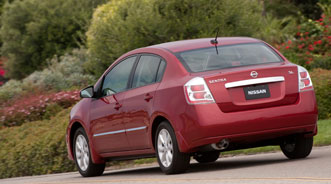Nissan Posts Best-Ever Global Sales, While It Continues Japan Recovery

The end to the fiscal year for Nissan was somewhat of an enigma.
The Japanese automaker was in the midst of wrapping up the most successful year for global vehicle sales in its history when the March 11 disasters in Japan put Nissan and its island nation peers temporarily back in “recovery mode,” as president and chief executive Carlos Ghosn put it.
However, the company has made significant progress in the two months since the disasters, and the automaker’s production is projected to be at full strength by October, according to Ghosn.
“Based on the most recent updates from our suppliers, we expect to resume full and unrestricted production at all our plants in Japan and overseas in October,” he said at a media conference in Japan this week.
“Since the earthquake on March 11, circumstances affecting our operating environment have been changing daily. We are constantly reevaluating the impacts and adjusting our management accordingly,” he continued. “For these reasons, we have decided that it would be premature to provide a forecast for fiscal-year 2011 at this time. But we will be targeting our shareholders meeting in June to give you our forecast for the full year.”
Vehicle production was booted back up at Nissan’s plants on April 11, and production was restarted on the VQ assembly line at the Iwaki engine plant on April 18. Nissan expects the rest of the lines at Iwaki to kick back into gear sometime in May.
Nissan is still monitoring parts availability and Ghosn said things are looking up.
“While the disaster left many Nissan suppliers too severely damaged to restore production and we still face supply constraints, the situation is improving,” Ghosn stressed. “On a daily basis, we are working closely with suppliers to confirm parts availability.”
The CEO went on to note that Nissan’s main challenges stemming from the earthquake boil down to three key points, the first of which is the supply chain disruption.
Ghosn said Nissan is striving to help suppliers so they recover swiftly. The automaker is also going after alternative parts and component supply sources in cases of “continued risk in the supply chain.”
Next, Ghosn cited electricity concerns, as overwhelming demand may be on the horizon during summer. In response, Nissan is preparing to install conservation measures.
“We will consider more nighttime operations and in-house electricity generation,” he noted. “We will also study a policy proposed by the Japanese Automotive Manufacturers Association to change the days of operations by industry, as a countermeasure for the total shortage of electricity.”
Lastly, Ghosn said Nissan is still dealing with “harmful rumors about radioactive contamination from the damaged Fukushima nuclear power plant.”
He emphasized: “We began conducting radiation testing on our products in March and continue to confirm the safety of all Nissan exports through proactive screening measures.”
Fiscal Performance Metrics
Moving along, Ghosn also dived into the fiscal year that wrapped up March 31. Worldwide, the automaker sold 4.19 million units, an increase of 19.1 percent year-over-year and the highest global sales ever for the automaker.
The company pulled in net income of 319.2 billion yen, which translates to $3.72 billion USD. Ordinary profit was 537.8 billion ($6.28 billion) and operating profit was 537.5 billion yen ($6.27 billion).
Nissan’s revenue hit 8.77 trillion yen, which is $102.37 billion USD.
Nissan achieved 5.8 percent full-year market share.
"Fiscal-year 2010 was a record year for Nissan in terms of sales and growth," Ghosn said in a statement. "Our recovery efforts were effective, and new models launched in the second half — including the all-electric Nissan LEAF — boosted our brand and sales power in the world’s major markets.”
In one of those markets, China — which happens to be the automaker’s biggest in terms of single markets — Nissan had its best year ever for new-vehicle sales. Its unit sales climbed 35.5 percent to 1.02 million vehicles. This comprises about a fourth of Nissan’s global sales, Ghosn said.
North America Shows Growth
Moving over to the North America, Nissan said its sales climbed 16.6 percent to 1.25 million units. In the U.S., in particular, Nissan moved 966,000 vehicles, which marks a 17.3-percent hike.
The automaker grabbed 8 percent market share in the U.S., representing an all-time high for the company and an increase from 7.6 percent the prior year. The company’s leasing penetration in the U.S. also surged to 28 percent, compared to 22 percent in fiscal 2009, according to data provided by Edmunds.com
Edmunds’ data also indicates that even though Nissan’s U.S. incentives surged in the second quarter (up 14 percent year-over-year), the full-year average incentives climbed only 2.5 percent.
“Generous incentives spending helped Nissan capture record market share in the last month of the fourth quarter, but once they dropped their incentives, the company was unable to sustain its share in April,” said Jessica Caldwell, director of industry analysis for Edmunds.com
“Like other Japanese automakers affected by the March earthquake, Nissan will have difficulty holding on to its share with a strained supply in the face of fierce competition from companies like Ford and Hyundai,” she added.
However, in light of higher fuel costs, Nissan’s lineup is particularly suited to succeed, said Edmunds.com senior analyst Michelle Krebs.
“Nissan has been well-positioned for higher gas prices in the U.S., with a number of small vehicle entries, like the Versa, Sentra and Rogue,” she suggested.
“The quirky design of the Nissan Juke has also captured the fancy of American car buyers, selling beyond Nissan’s expectations. And the Nissan Leaf earned a round of good publicity as the first recent all-electric car in America,” Krebs concluded.


